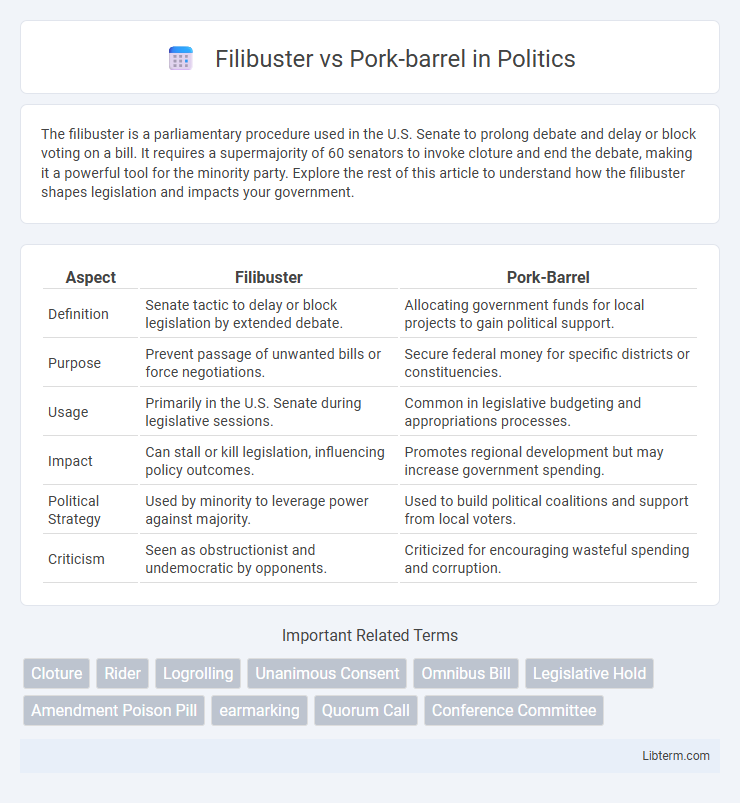The filibuster is a parliamentary procedure used in the U.S. Senate to prolong debate and delay or block voting on a bill. It requires a supermajority of 60 senators to invoke cloture and end the debate, making it a powerful tool for the minority party. Explore the rest of this article to understand how the filibuster shapes legislation and impacts your government.
Table of Comparison
| Aspect | Filibuster | Pork-Barrel |
|---|---|---|
| Definition | Senate tactic to delay or block legislation by extended debate. | Allocating government funds for local projects to gain political support. |
| Purpose | Prevent passage of unwanted bills or force negotiations. | Secure federal money for specific districts or constituencies. |
| Usage | Primarily in the U.S. Senate during legislative sessions. | Common in legislative budgeting and appropriations processes. |
| Impact | Can stall or kill legislation, influencing policy outcomes. | Promotes regional development but may increase government spending. |
| Political Strategy | Used by minority to leverage power against majority. | Used to build political coalitions and support from local voters. |
| Criticism | Seen as obstructionist and undemocratic by opponents. | Criticized for encouraging wasteful spending and corruption. |
Introduction to Filibuster and Pork-barrel
The filibuster is a legislative tactic used in the U.S. Senate to delay or block a vote by extending debate, often through prolonged speaking. Pork-barrel politics refers to the allocation of government funds for local projects secured by legislators to benefit their constituents, often to gain political support. Both strategies play significant roles in shaping legislative outcomes and political negotiations.
Historical Origins of Filibuster
The filibuster originated in the mid-19th century as a Senate tactic to extend debate and delay or prevent votes, first notably employed by Senator Henry Clay in 1837. Its roots trace back to the Senate's tradition of unlimited debate designed to protect minority opinions within the legislative process. This contrasts with pork-barrel spending, which emerged later as a political strategy to secure government funds for localized projects benefiting specific constituencies.
Historical Development of Pork-barrel
Pork-barrel spending emerged prominently during the 19th century as legislators sought to secure federal funds for local projects to benefit their constituents, often in exchange for political support. This practice expanded with the growth of federal government programs in the early 20th century, becoming a central tool for securing reelection through targeted infrastructure and public works funding. Over time, pork-barrel politics attracted criticism for promoting wasteful expenditures and fostering patronage, yet it remains influential in congressional appropriations and budget negotiations.
Key Differences Between Filibuster and Pork-barrel
The filibuster is a legislative tactic used in the U.S. Senate to delay or block voting on a bill by extending debate, requiring a supermajority of 60 votes to invoke cloture and end it. Pork-barrel refers to the allocation of government funds for local projects designed to please voters or legislators, often leading to targeted spending to gain political support. While the filibuster concerns procedural obstruction to influence legislation, pork-barrel involves strategic budgeting to secure electoral advantages through localized benefits.
How Filibuster Impacts Legislative Process
The filibuster significantly impacts the legislative process by allowing a minority of senators to delay or block voting on a bill through extended debate, often requiring a supermajority of 60 votes to close debate via cloture. This procedural tool can stall or prevent legislation, incentivizing compromise or causing political gridlock when consensus is lacking. The filibuster's power shapes legislative strategy, influencing which bills reach the floor and how lawmakers negotiate policy priorities.
Effects of Pork-barrel Spending on Policy
Pork-barrel spending often leads to inefficient allocation of resources by directing funds to localized projects with minimal national benefit, distorting policy priorities. This practice fosters political patronage, undermines transparent budget processes, and weakens legislative accountability. Consequently, pork-barrel spending can compromise policy effectiveness by incentivizing legislators to prioritize parochial interests over comprehensive, evidence-based decision-making.
Controversies Surrounding Filibuster
The filibuster sparks significant controversy due to its potential to stall legislative progress by allowing a minority of senators to block bills indefinitely, raising concerns about democratic gridlock and obstructionism. Critics argue it enables partisan tactics that undermine majority rule and delay urgent policy decisions, while supporters claim it protects minority interests and encourages bipartisan compromise. These debates intensify during high-stakes legislation, highlighting tensions between efficient governance and minority rights within the U.S. Senate.
Criticisms of Pork-barrel Projects
Pork-barrel projects face criticism for promoting government waste by funding localized projects that benefit a small group rather than the public good. These projects often lead to inefficient allocation of resources, driven by political motives rather than economic necessity or merit. Critics argue pork-barrel spending undermines transparency and accountability, fostering corruption and favoritism in legislative processes.
Modern Examples: Filibuster and Pork-barrel in Action
Modern examples of filibusters include Senator Rand Paul's 13-hour speech in 2013 opposing the nomination of John Brennan as CIA director, demonstrating the tactic's use to delay or block legislation. Pork-barrel spending is evident in projects like the "Bridge to Nowhere" in Alaska, which allocated $398 million for a bridge with little strategic value, highlighting localized spending aimed at benefiting specific constituencies. These instances showcase how filibusters and pork-barrel projects continue to influence legislative processes and budget allocations in contemporary politics.
Future of Filibuster and Pork-barrel in Politics
The future of the filibuster in U.S. politics faces increasing challenges as Senate Democrats push for reforms to enable smoother legislative processes, while Republicans view its potential elimination as a threat to minority party power. Pork-barrel spending continues to evolve with growing public scrutiny and demands for fiscal responsibility, prompting legislators to seek more transparent and targeted project funding. Both filibuster reform and pork-barrel practices will significantly influence Congressional dynamics, affecting bipartisan cooperation and budgetary priorities in upcoming legislative sessions.
Filibuster Infographic

 libterm.com
libterm.com